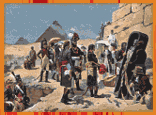 |
 |
 |
|
|||
|
The Great Pyramid of Giza My first reaction to the great pyramid of Cheops, as well as the neighboring pyramids of Chefren and Mycerinus, was disappointment. They weren't quite as big as I thought they'd be, but then again, some people feel the same way about the Mona Lisa. It's just that the monumental, popular image of the pyramids has been so burned into our collective psyches that when you actually see them, you say to yourself, so this is it? This is what all the fuss is about? But perspective is a funny thing. It isn't until you get close and gaze up at one of the pyramid's vast triangular faces, this oceanic mass of chiseled stone, that it begins to dawn on you just how big they really are. 
I wasn't alone in my reaction. I don't mean the four to five thousand tourists that crowd the place each day. I mean some of the earlier, solitary visitors to Giza, guys like Dominique Vivant Denon, a sketch artist with the French expedition to Egypt in 1798, under the command of Napoleon Bonaparte.
Just walking around the 13-acre base of the Great Pyramid, the equivalent of more than 350 New York City blocks, gives you a pretty good sense of that immensity. Then there are the oft-repeated, but nonetheless impressive statistics: 2.3 million blocks of stone, each weighing two and half tons, stacked so precisely you can't slip a credit card, or in Cheops' day, a sheet of papyrus, between them. Soaring 450 feet above the plateau, the great pyramid was once about thirty feet higher. That was before the Romans stripped it of its polished, white limestone outer casing, which they ground into plaster. 
But it sure must have been something to see gleaming there in the desert sun, decorated, as the fifth century Greek historian Herodotus informs us, with carved images and hieroglyphics.
The priests who gave Herodotus the VIP tour of Cheops' pyramid in 450 B.C. had few kind words for its builder.
Zahi Hawass, Undersecretary of State for the Giza monuments, says that in this case, the wool was being pulled firmly over Herodotus' eyes.
As Hawass points out, getting hustled at the pyramids is an old game, and a jealously guarded one at that. According to English travel writer, Amelia Edwards, who scaled the Great Pyramid in 1874, no longer an option, by the way, local Arab guides were more than happy to help her clamber to the top, as long as she minded her own business. 
The hucksters are still here, but in a recent controversial decision, Undersecretary Hawass segregated them all to a central area outside the pyramid complex. He says it'll even the playing field for them all. They say he's putting them out of business. As for the great pyramid, well, if six million tons of carved limestone could shrug I suppose it would. When you're one of the oldest man-made things on earth, nothing man does anymore comes as much of a surprise. At the pyramids of Giza, I'm Tom Verde for The Savvy Traveler. Thanks go to Marketplace Productions, Helen Palmer, Robert Da Pont and David Jaffee, Director of the National Theater Institute at the Eugene O'Neill Theater Center in Waterford, Connecticut for their help in this production.
|
 | American Public Media Home | Search | How to Listen ©2004 American Public Media | Terms of Use | Privacy Policy |
